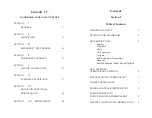
9
2.5.2 CHANGING THE RISER CORDS.
In spite of the speed system having pulleys with bearings to reduce
friction to a minimum, the frequency with which the speed-bar is used
causes the cord to wear and you may need to replace them.
In all Niviuk gliders the speed system cords on the risers are completely
removable and easily replaceable. You can use the Brummel hooks, not
use them, remove them, use another type of connector, etc. It is even
possible to fix the speed-bar cords directly to the speed system on
the risers. This last option makes the connection / disconnection more
laborious, but means the cord has maximum travel without obstructions
or restrictions which is very useful for some models of harnesses.
2.6 INSPECTION AND WING INFLATION ON THE GROUND
After your gear has been thoroughly checked and the weather conditions
deemed favourable for flying, inflate your PEAK 5 as many times as
necessary to familiarise yourself with its behaviour. Inflating the PEAK 5
is easy and should not require a great deal of physical effort. Inflate the
wing with a little pressure from the body using the harness. This may
be assisted by using the A-lines. Do not pull on them; just accompany
the natural rising movement of the wing. Once the wing is inflated to the
overhead position, appropriate control with the brakes will be sufficient to
hold it there.
2.7 ADJUSTING THE BRAKES
The length of the main brake lines are adjusted at the factory and conform
to the length stipulated during certification. However, they can be
changed to suit your flying style. It is advisable to fly with the original
setting for a period of time to get used to the actual behaviour of the PEAK
5 . In case it is necessary to modify the brake length, loosen the knot,
slide the line through the brake handle to the desired point and re-tighten
the knot firmly. Only qualified personnel should carry out this adjustment.
You must ensure that the modification does not affect the trailing edge
and slow the glider down without pilot input. Both brake lines should be
symmetrical and the same length. We recommend using a clove hitch or
bowline knot.
When changing the brake length, it is necessary to check that they do
not engage when the speed-bar is used. When we accelerate, the glider
rotates over the C-riser and the trailing edge elevates. It is important
to check that the brake is adjusted to take into consideration this extra
distance during acceleration. With this profile deformation there is a risk of
generating turbulence and causing a frontal or asymmetric collapse.
3. THE FIRST FLIGHT
3.1 CHOOSE THE RIGHT LOCATION
For the first flight we recommend going to your usual flying area and that
a qualified instructor is present and supervising the entire procedure.
3.2 PREPARATION
Repeat the procedures detailed in chapter 2 UNPACKING AND
ASSEMBLY in order to prepare your equipment.
3.3 FLIGHT PLAN
Planning a flight before taking off to avoid possible problems later is
always a good idea.
3.4 PRE-FLIGHT CHECK LIST
Once ready, but before taking off, conduct another equipment inspection.
Conduct a thorough visual check of your gear with the wing fully open, the
lines untangled and properly laid out on the ground to ensure that all is in
working order. Be certain the weather conditions are suited to your flying
skill level.
Summary of Contents for PEAK 5
Page 1: ...PEAK 5 User s manual...
Page 21: ...10 3 RISERS PLAN 22...
Page 22: ...10 4 SUSPENSION PLAN 23...
Page 27: ...niviuk com...









































